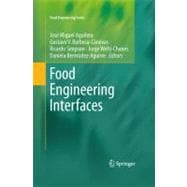
What is included with this book?
| Selected Topics in Food Engineering | |
| The Beginning, Current, and Future of Food Engineering: A Perspective | p. 3 |
| Advances in 3D Numerical Simulation of Viscous and Viscoelastic Mixing Flows | p. 19 |
| CFD: An Innovative and Effective Design Tool for the Food Industry | p. 45 |
| Incorporation of Fibers in Foods: A Food Engineering Challenge | p. 69 |
| Gastric Digestion of Foods: Mathematical Modeling of Flow Field in a Human Stomach | p. 99 |
| State of the Art in Immobilized/Encapsulated Cell Technology in Fermentation Processes | p. 119 |
| Multifactorial Assessment of Microbial Risks in Foods: Merging Engineering, Science, and Social Dimensions | p. 147 |
| Development of Eco-efficiency Indicators to Assess the Environmental Performance of the Canadian Food and Beverage Industry | p. 165 |
| Food Process Economics | p. 219 |
| Systemic Approach to Curriculum Design and Development | p. 237 |
| Advances in Food Process Engineering | |
| Innovations in Thermal Treatment of Food | p. 247 |
| Optimization of Food Thermal Processing: Sterilization Stage and Plant Production Scheduling | p. 261 |
| Recent Advances in Emerging Nonthermal Technologies | p. 285 |
| High-Pressure-Induced Effects on Bacterial Spores, Vegetative Microorganisms, and Enzymes | p. 325 |
| High Pressure Sterilization of Foods | p. 341 |
| Bioseparation of Nutraceuticals Using Supercritical Carbon Dioxide | p. 353 |
| Mass Transfer and Equilibrium Parameters on High-Pressure CO2 Extraction of Plant Essential Oils | p. 393 |
| Water Management in Food | |
| Glass Transitions: Opportunities and Challenges | p. 473 |
| Caking of Water-Soluble Amorphous and Crystalline Food Powders | p. 491 |
| Effective Drying Zones and Nonlinear Dynamics in a Laboratory Spray Dryer | p. 515 |
| Rehydration Modeling of Food Particulates Utilizing Principles of Water Transport in Porous Media | p. 535 |
| Responses of Living Organisms to Freezing and Drying: Potential Applications in Food Technology | p. 553 |
| Food Microstructure | |
| Food Microstructures for Health, Well-being, and Pleasure | p. 577 |
| Fruit Microstructure Evaluation Using Synchrotron X-Ray Computed Tomography | p. 589 |
| Multifractal Characterization of Apple Pore and Ham Fat-Connective Tissue Size Distributions Using Image Analysis | p. 599 |
| Food Packaging | |
| New Packaging Materials Based on Renewable Resources: Properties, Applications, and Prospects | p. 619 |
| Edible Coatings to Improve Food Quality and Safety | p. 631 |
| Physical Properties of Edible Gelatin Films Colored with Chlorophyllide | p. 661 |
| Index | p. 679 |
| Table of Contents provided by Ingram. All Rights Reserved. |
The New copy of this book will include any supplemental materials advertised. Please check the title of the book to determine if it should include any access cards, study guides, lab manuals, CDs, etc.
The Used, Rental and eBook copies of this book are not guaranteed to include any supplemental materials. Typically, only the book itself is included. This is true even if the title states it includes any access cards, study guides, lab manuals, CDs, etc.